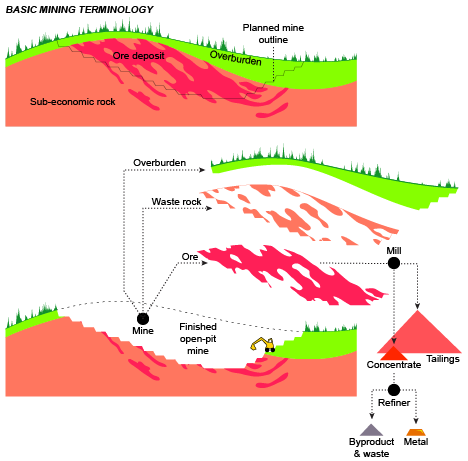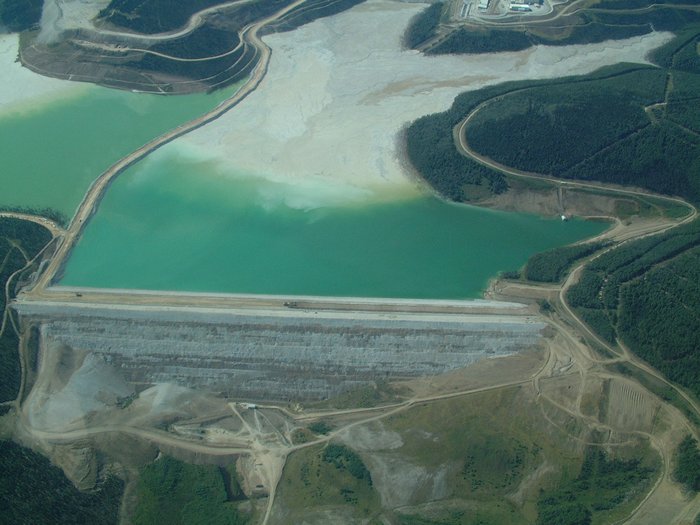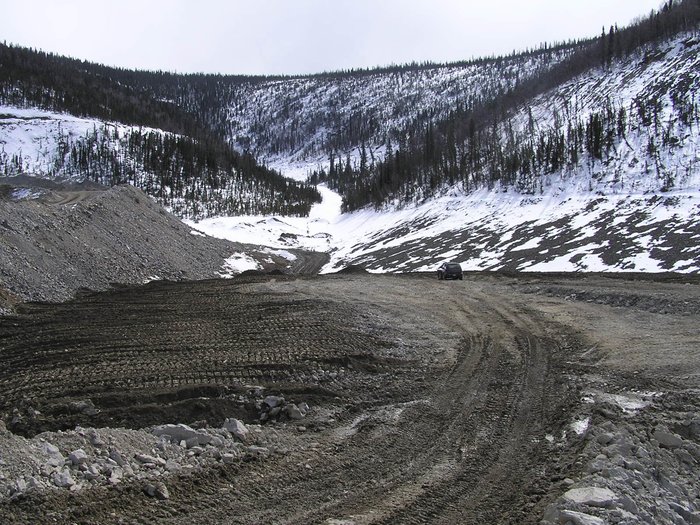

Mine tailings are the ore waste of mines, and are typically a mud-like material.
Worldwide, the storage and handling of tailings is a major environmental issue. Many tailings are toxic and must be kept perpetualy isolated from the environment. Scale of tailings production is immense, since metal extraction is usually only ounces or pounds, for every ton of ore. Tailings containment facilities are regarded as the world’s largest man-made objects.
Terminology
Mine tailings’ size and composition depends on the mining method. For hardrock metal mines, tailings are usually a very fine mud or powder, which is left over after ore is crushed and valuable minerals are extracted from it. Tailings may also contain chemicals used for mineral extraction.
Tailings are distinct from “waste rock”, which is the non-ore rock which miners move and discard as they dig down to access the underlying ore. They are also distinct from soil and organic matter (collectively known as “overburden”), which is removed from the surface above the ore deposit.
Oil sands production also produces tailings, which are substantially different. Oil sands tailings are the residue which remains after bitumen is separated from virgin oil sands. Although this article focuses on hardrock tailings, oil sands tailings can contain a similarly complex and toxic brew of minerals and chemicals, and pose a similar handling and storage challenge.
Disposal
Disposal of mine tailings is usually the single biggest environmental concern facing a hardrock metal mine, and creates very long-term environmental liabilities which future generations must manage. Many mine tailings do not become appreciably safer over time, if stored properly, and therefore must stored for an indefinite period using current technology.
The historically-used alternative to storage was to dispose of tailings in the most convenient way possible (such as river dumping), which led to widespread environmental contamination in mining areas. This was nominally viable in earlier eras, but human production of mine tailings has increased by several orders of magnitude in the modern age, making such methods unacceptable to many societies.

This tailings impoundment dam at the Fort Knox gold mine in Alaska is a common method of storing mining waste forever.
 — 
<a class="figure-caption__link" href="/photos/typical-mine-tailings-dam/">Get Photo</a></figcaption></figure>Hazardous Properties
Toxic chemicals used to extract the valuable materials from the ore, such as the cyanide used in gold mining, remain in the tailings at the end of the process, and may leach out into ground water. Rock may naturally contain dangerous chemicals, such as arsenic and mercury, which leach into water much more readily after rock has been ground up and exposed to the wind and the rain.
Acid mine drainage is the most frequent and widespread problem. Many hardrock mines (including most gold mines) extract minerals that are bound up with sulfide compounds. These compounds produce sulfuric acid on contact with air and water, a process that occurs at a very low rate in undisturbed rock, at a higher rate in unprotected waste rock (which has a large surface area and is now exposed to air) and a much higher rate in unprotected mine tailings which have a massive surface area. The result can be the production of very acidic water, which additionally leaches metals and other chemicals from the surrounding rock.
Wet Storage in Pits & Lakes
Most modern hardrock metal mines dispose of tailings as a wet mud, held in pits lined with clay or a synthetic liner. Many mines put the tailings back into the original mining pit. Some large mines use entire existing valleys sealed off with earthen dams, and others store tailings in natural lakes. In most cases, disposal pits are covered with water, forming an artificial lake which reduces the rate of acid formation.
Wet storage often requires long-term oversight, to monitor and attempt to mitigate contaminated groundwater movement, and to maintain any crucial facilities, such as dams. Many wet storage facilities require perpetual water treatment.

On-Land Storage (“Dry-Stack”)
In “dry-stack” disposal, tailings stored in dry form, typically by burial in a covered and lined pit. In this regard, dry-stack storage is more similar to a modern, sealed landfill. This method takes up much less space, is less susceptible to earthquake hazards, and doesn’t require active water treatment. This makes it particularly relevant in locations where precipitation, earthquake risk are high, or space is limited.
However, dry-stack disposal has much higher up-front costs than wet storage. Dry-stack tailings must be dried, and the solid tailings must be transported by truck or conveyor instead of by slurry pipeline, which adds logistical complexity and cost.
Pits covers for dry-stack storage, like the damns around artifical lake impoundments, must be maintained in perpetuity. However, the long-term maintenance is much less than it is for large, wet tailings impoundment with dams.
In Alaska, Pogo Mine, Greens Creek Mine, and Nixon Fork Mine use dry-stacking for tailings disposal. In contrast, the Fort Knox and Red Dog mines use artifical wet impoundments with earthen dams, and Kensington Mine stores its tailings in a natural lake.
Alaska Mines: 2012 Production
Metric tons
Mine | Ore Mined | Metal Production | Waste Rock Moved | Tailings Produced | Tailings Disposal & Notes | Source
Fort Knox
28,60,000
~13 tons gold
34,50,000
10,400,000 t0 13,600,000
Tailings 100% impounded; additional ore heap leached.
Fort Knox DNR Report, 2013
Red Dog
3,746,526
596,000 tons zinc & lead
Est. 8,000,000
2,441,000
Tailings 100% impounded. Major acid generation potential.
Red Dog DNR Report, 2012
Pogo
815,922
~10 tons gold
460,000
Not identified
60% dry-stack, 40% underground backfill.
Pogo DNR Report, 2012
Kensington
405,343
2.6 tons gold
203,463
384,269
70% lake impounded, 30% underground backfill.
Kensington DNR Report, 2012
Greens Creek
288,490
199 tons silver, 21,000 tons lead, other precious metals. (Alaska DNR)
Not identified
288,490
Dry-stack and underground backfill (ratio not identified). Major acid generation potential.
Greens Creek 2012 tailings report.
Further Reading
Created: Jan. 19, 2018